User:Speddie2/Sandbox
This is my sandbox



In optics, an aperture is a hole or an opening through which light travels. More specifically, the aperture of an optical system
Application[edit]

The aperture stop is an important element in most optical designs. Its most obvious feature is that it limits the amount of light that can reach the image/film plane. This can either be undesired, as in a telescope where one wants to collect as much light as possible; or deliberate, to prevent saturation of a detector or overexposure of film. In both cases, the size of the aperture stop is constrained by things other than the amount of light admitted; however:
- The size of the stop is one factor that affects depth of field. Smaller stops (larger f numbers) produce a longer depth of field, allowing objects at a wide range of distances to all be in focus at the same time.
- The stop limits the effect of optical aberrations. If the stop is too large, the image will be distorted. More sophisticated optical system designs can mitigate the effect of aberrations, allowing a larger stop and therefore greater light collecting ability.
- The stop determines whether the image will be vignetted. Larger stops can cause the intensity reaching the film or detector to fall off toward the edges of the picture, especially when for off-axis points a different stop becomes the aperture stop by virtue of cutting off more light than did the stop that was the aperture stop on the optic axis.
- A larger aperture stop requires larger diameter optics, which are heavier and more expensive.
